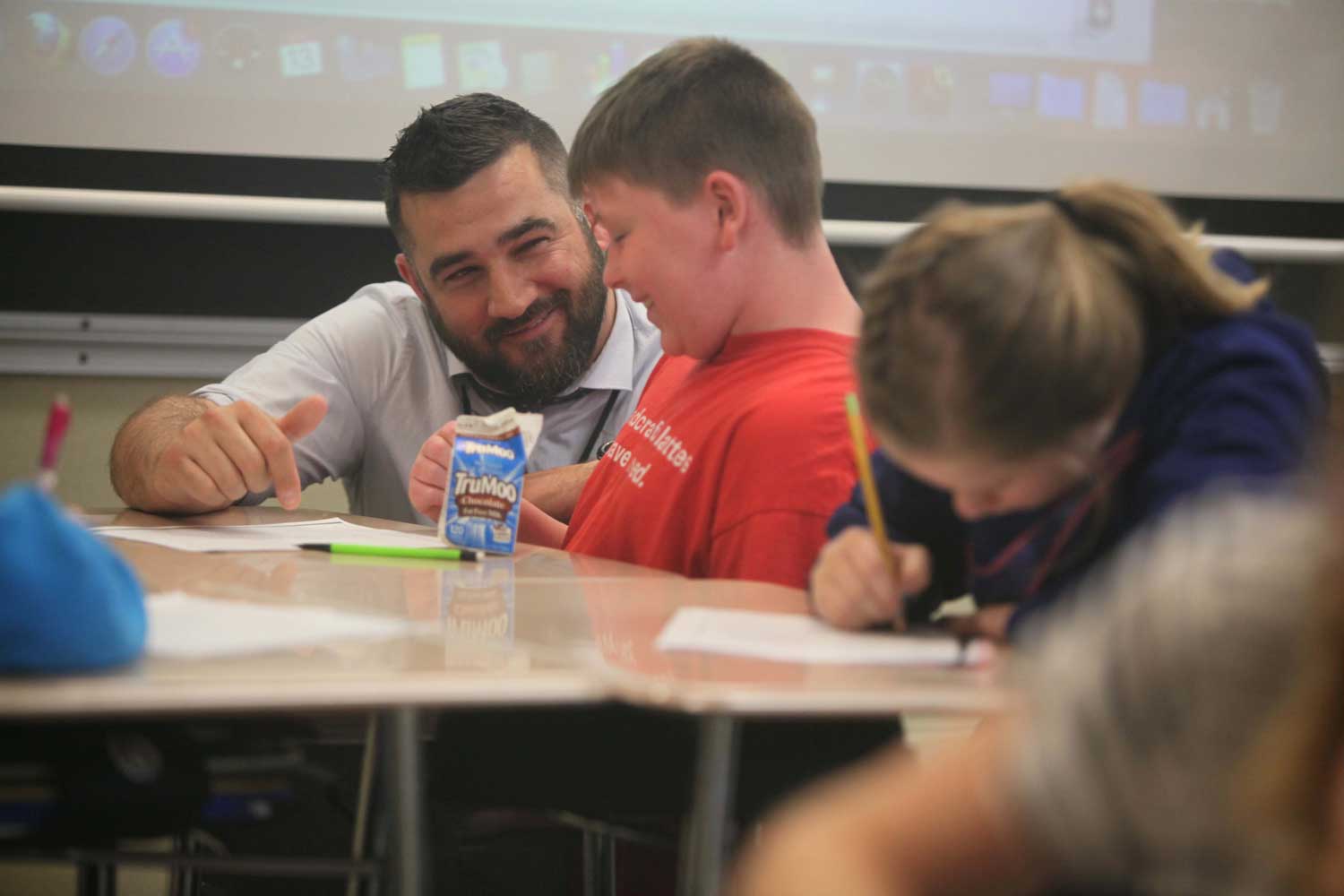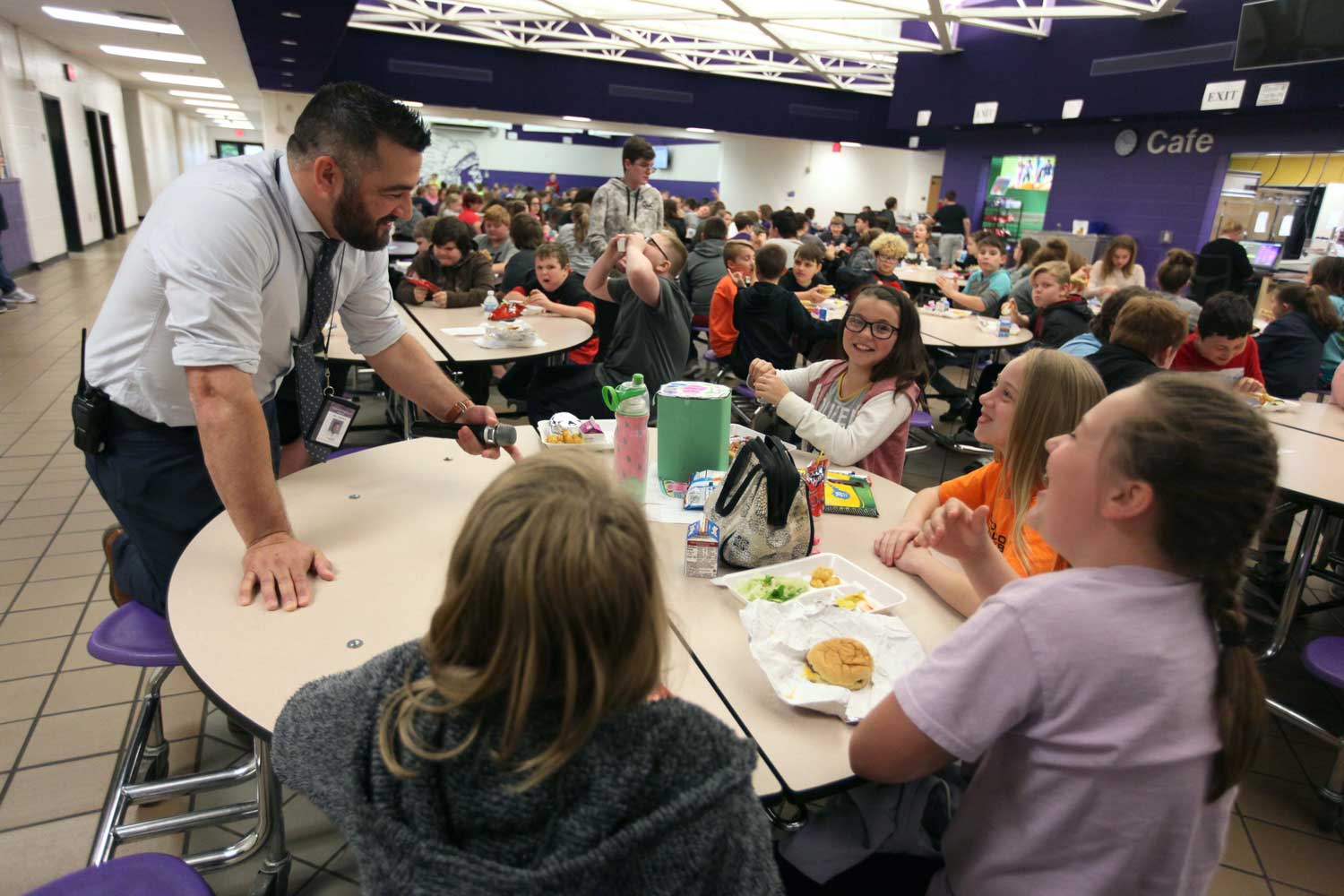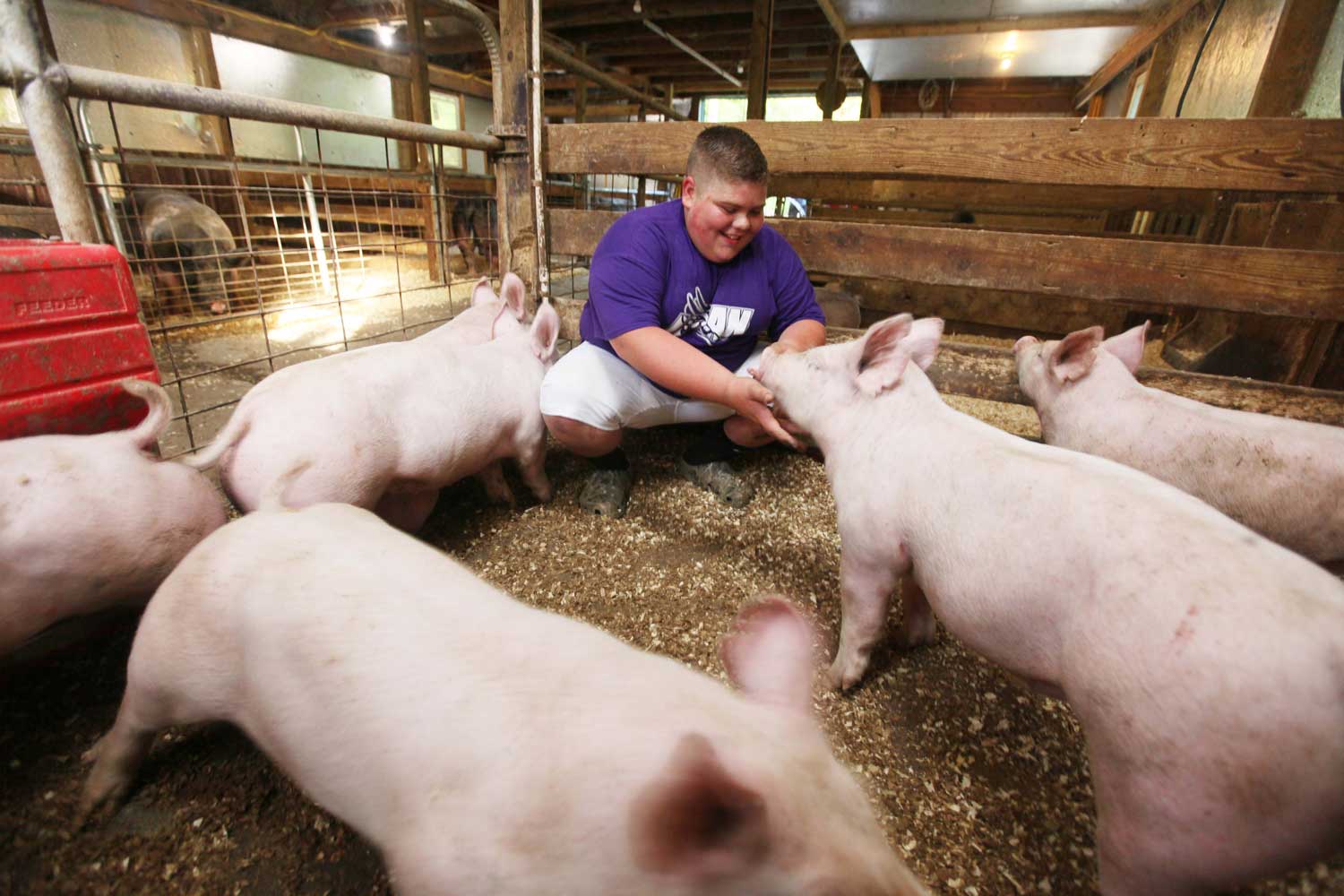College looks to shore up education gaps, economic disparity in Ohio’s outlying communities
A seventh-grade boy held court at his lunch table as a half-dozen others convulsed with laughter at his antics. Jayden Woodgeard held back nothing — even putting a twist on the old science class meme about Uranus.
To his buddies’ immense glee, he proclaimed: “I like Mr. Hacker (the principal) because he lets us cuss sometimes. But we know our limits.”
Mr. Hacker, also known as Eli, grew up one of four sons in Hocking County, where he served until July as principal of Logan-Hocking Middle School. (He’s now assistant principal at the county’s only high school.) He received his principal’s licensure from the college in 2016.
Hacker rolled his eyes at the notion that he’s soft on coarse language. “There are times when students slip and say a word they shouldn’t,” he said. Then he and the student talk. But he understands kids in the community, among the most rural and economically disadvantaged Ohio districts, because he was one.
Common to rural America, the school district is Hocking County’s largest employer (441 jobs), followed by county government and Walmart. At the schools, Hacker’s mother is a librarian; his sister-in-law, an art teacher; his stepmom, a cook. His nieces and nephews are among his students. “If they get it trouble it will be weird,” he said. They don’t.
Some residents commute more than an hour to Columbus jobs because their families have lived here for generations. The taxes are cheaper, the sense of community is rich, the scenery, stunning. And like some rural districts, the schools are doing relatively well. Hawkish about expenditures, the district is in the black. Logan-Hocking received a C on its last state report card, and its graduation rates are high.
Where Logan-Hocking and other rural students suffer, however, bears striking resemblance to their counterparts in inner-city schools.
The number of residents with bachelor’s degrees in Hocking County is less than half the national average of 33%. Tech-heavy jobs that drive economies require highly skilled workers. Such companies have sidestepped southeastern Ohio, which has the highest levels of unemployment in the state. Logan-Hocking Middle School — better off than others — still runs two clothing closets and a food pantry for its students in need.
Some resources like interactive whiteboards are in short supply, said Laura Smith, ’14, a physical activity teacher at the school. In a one-middle-school, one-high-school county like Hocking, long distances and lack of transportation keep kids from participating in afterschool activities — another catalyst for success.
And the community still deals with the fallout of an opioid crisis that for years disproportionately ravaged rural America. “Lots of kids have been raised by grandparents,” Hacker said. “Sometimes it’s great grandparents raising kids.”
Mental health resources are limited. Teachers try to stay in the loop, but kids this age often hold back about parental addictions. “Until it’s almost too much for them to bear or they’re in trouble,” Hacker said. They might get kicked off the bus, or act up in class. “They just kind of break down. They can’t take it anymore.”

Power in education
These problems, rooted in economic disparity, can be mitigated, said Dean Don Pope-Davis.
“I believe that the power of education is one of the most dependent variables,” Pope-Davis said.
“If you miss this pivotal opportunity, you send yourself down a particular course in life that is difficult to change. Our challenge is to get students to see beyond this moment and to provide them skills to imagine new possibilities.”
That’s true whether you’re a black kid in inner-city Columbus or a white kid in Appalachian Ohio. Though the difficult work of fixing urban education is not finished, rural communities have been neglected.
“The rural communities have the same socio-economic, first-generation education challenges that we see in urban communities,” Pope-Davis said. “Yet, we have not paid equal attention to how we can impact those communities.”
More than half of U.S. school districts are rural, serving one-fourth of public school students. But during the last 15 years, the No Child Left Behind Act drove nearly all education research to center on urban schools. At Ohio State, that is changing. Pope-Davis has appointed a task force, under the leadership of Associate Dean Noelle Arnold, to launch the Urban and Rural Education Initiative, which will partner with both types of communities to create opportunities that bring educational parity.
Faculty and postdoctoral researchers will be tasked to study and engage in community partnerships to help solve education issues.
“The hope is to make the initiative distinctive by finding out from the community what their needs and concerns are, by engaging in a new and different conversation,” he said. “Tell us what you need. Tell us how we can become better collaborators.”
“How do we get them to pivot? It begins by changing the conversation,” he said. “And the way you do this, is you change the people you’re talking to. Then, new possibilities and opportunities emerge.”

Fighting a killer epidemic
So-called deaths of despair — drug overdose, suicide and fatal alcoholism brought on by socio-economic insecurity — have hit declining rural areas indiscriminately since 2008. The college is partnering across campus and the state to tackle opioid addiction.
Ohio State is leading a $65.9 million federal research effort to reduce opioid overdose deaths by 40% over three years. Michael Betz, assistant professor of human development and family science, is a key co-investigator.
“The grant is comprehensive, attacking every point along the way that could influence why someone would overdose,” he said.
His part in the grant expands to 19 rural and urban counties his work on another grant: teaching sixth- and seventh-graders evidence-based life skills to avoid experimenting with drugs. In the glacial till plains of northwest Ohio, for example, OSU Extension educators led Kenton Middle Schoolers last spring to role-play coping skills and communicate with peers and adults. Called PROSPER, the curriculum was first introduced in rural Iowa.
“They found that 6.5 years out, it’s still having an impact on behaviors,” Betz said. The effect is bolstered when parents are trained to better communicate with children.
Cities’ opioid death rates are now outpacing those in the country, so Betz’s research also will measure if the curriculum is as effective in urban areas as it has been in rural communities.
Regional campuses: Key to the solution
Meanwhile, many rural children continue to deal with issues like limited parental education — the greatest determinant of student success — and lack of technology access at home. Kenton Middle School students linger outside school after hours, tapping into Wi-Fi so they can finish homework, their principal said.
Rural teachers remain on the frontlines, providing boosts that can push children over hurdles. The college — particularly at regional campuses, where many students from rural backgrounds attend — has provided that training for decades. Many of those students get pre-service teaching opportunities in rural schools.
“We put the theory and the research out there for teaching students,” said Christine Warner, associate professor of reading and literacy at Ohio State’s Newark Campus. “Then we lead them. How do you develop the pedagogy? You have a kid whose parent is in recovery, and you have got to teach him X, Y and Z.”
“It might not be a simple strategy,” she said. “How are you going to get that student to find meaning in what you are teaching?”
In rural Ohio public schools, 114 of the college’s graduates were hired as teachers or other instructors from 2017 to 2018. That quality instruction, from the most highly ranked teaching college in the state, is having an impact.
University statistics show regional campus students, particularly women, are getting younger. Professor Diana Erchick said more of her education students are second generation.
“Their mothers had jobs as nurses, in business,” said Erchick, professor of multicultural and equity studies in education at Newark. “They saw the benefit of education for their own growth. To me, that’s where our hope lies, because those parents will bring their children to us. And their children will teach more children.”

Preventing dropouts
Some features of rural America are universal. The parking lot at Geauga County’s Cardinal High School, in far northeast Ohio, has as many pickup trucks as cars. Inside, kids in camo jackets and sweats milled around the commons eating cafeteria-grade pizza.
But even within Ohio, regions are distinct. Absent at Cardinal High are the Amish students who once attended elementary and middle school nearby; they quit school after eighth grade. A number of non-Amish, or “English” students, also dropped out last year as well, just shy of graduating.
“It is a huge struggle right now,” Interim Superintendent Bill Kermavner said. “It’s brutal. We’re a small school. Students say, ‘Well, my parents didn’t get their high school diploma, and they’re successful.’ Their ideas of success are different.”
In fact, the government projects that a growing proportion of jobs will require postsecondary education. Those that don’t will provide significantly lower wages — 70% less, on average. And Ohio State research, in part by Michael Betz, shows that people with only high school degrees die of opioid overdose at rates 14 times higher than those with bachelor’s degrees.
Keeping kids in school is vital. Cyphert Distinguished Professor Kui Xie and his team met with Kermavner in March to discuss data collected at Cardinal for a grant project to improve digital learning in Ohio schools. Xie examined social-emotional aspects of students’ learning.
The research shows that the class with the high number of dropouts didn’t typically master subjects just because they valued learning — what experts call intrinsic motivation. Those students were mostly compelled to do school work because their parents made them, for example, or so they could earn a reward.
“Of course, intrinsic motivation tends to drive more sustainable engagement,” Xie said. “That’s the motivation we want to foster.”
The good news: Alternative teaching approaches can spur intrinsic motivation. Using new surveys, Xie’s team is working with the school to pinpoint earlier students in danger of dropping out, and offer ways to help bolster their motivation.
Helping rural Ohio
Jayden, the middle schooler who likes to make friends belly-laugh, doled out chow to show pigs he raises from farrow to finish — birth to slaughter — in his grandparents’ barn. Steeped in green, the landscape is perfect for racing dirt bikes and stomping through creeks.
Glenda Woodgeard can’t see raising her sons anywhere else. To be sure, this piece of Ohio feels worlds away from urban Columbus. Jayden’s parents both have jobs. His brother graduates from high school next spring and begins EMT training soon. Jayden likes the sound of that, too, but both boys know the local fire department has only so many jobs. They might have to settle elsewhere.
When Pope-Davis took the college’s helm last year, he embarked on statewide listening tours. In August, he attended a leadership day in eastern Ohio, with educators from some of the state’s most economically challenged areas.
His goal? To meet the Jaydens, the Eli Hackers, the Glenda Woodgeards. College faculty and staff are doing the same, laying groundwork for research and collaboration.
Through those conversations comes deeper understanding of rural Ohioans’ aspirations, economic challenges and barriers to education.
“Given the diversity of our state – racially, culturally, socio-economically – we are called by our land-grant mission to be the change agent that transforms the experiences of our community,” Pope-Davis said.
“Our mission as a college is to be a beacon of hope and change for all of Ohio, including rural citizens.”
